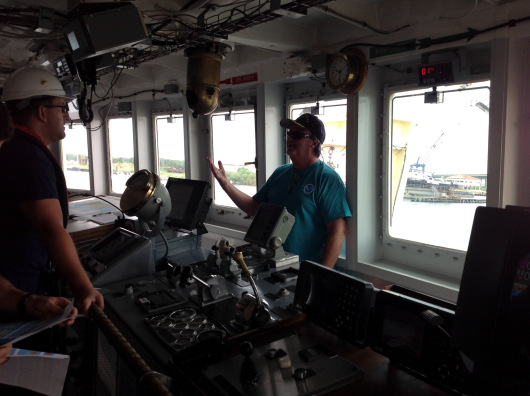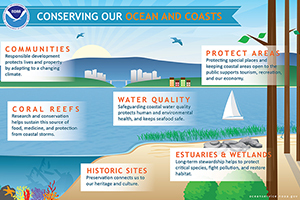NOAA Teacher a Sea
Barney Peterson
Aboard NOAA Ship Oregon II
August 13 – 28, 2016
Mission: Long Line Survey
Geographic Area: Gulf of Mexico
Date: Sunday, August 28, 2016
Weather Data is not available for this post because I am writing from the Biloxi/Gulfport Airport.
WHO WORKS ON NOAA SHIP OREGON II? (Part 1)
In the last few days I have had the opportunity to become better acquainted with some of the great people aboard the OREGON II. The variety of backgrounds and experiences provides richness to the culture we work in.
Firstly, there is our Commanding Officer, David Nelson. Upon meeting him when I came aboard I felt immediately welcomed by his warm, informal greeting, “Hi Teach.” His drawl gives him away as a life-long southerner. His friendliness and casual manner in conversation make it easy to see him as just one of the people who work here. BUT, make no mistake: Dave Nelson is a smart, perceptive, capable leader who understands ships and crews from the keel up.
CO Dave Nelson’s route to command has not been the typical college to NOAA Corp Officer track. He got where he is today by working through the ranks. After high school graduation he worked on commercial long-line and shrimp boats in the Gulf, gradually moving on to oil field supply boats. At some point he decided to look into marine work that offered worker benefits and more chance of vertical advancements. Dave had earned his card as an AB (Able Bodied Seaman) and been captain of fishing boats. He hired on as a Skilled Fisherman at NOAA and began a new phase of his career. His skills set matched the needs of NOAA well enough that he moved from deck hand to deck boss to 3rd, then 2nd officer and in 1998 he got his First Mate’s papers and became part of the wheel team.
Advancement at that point began to require more formal training and certification. He had had to invest 700 days at sea with NOAA to get that first license. The big prize became the Master rank requiring an additional 1000 days at sea and rigorous formal testing. He headed to Seattle where he enrolled at Crawford Nautical School, lived aboard NOAA Ship RAINIER at Sand Point, and spent seven days a week for 10 weeks immersed in preparing to take tests for the Master rank. It was a proud day in 2003 when he called his family to report success.
Today, Dave is one of only two people in command of NOAA ships who are not NOAA Corps officers. He brings to his job a depth of knowledge that positions him well to understand the challenges and rewards at every level on his ship. He appreciates the continuity possible for him because he is not subject to the mandatory rotation of postings every 2 or 3 years as are members of the Corps. He has the first-hand experience to know where the rough spots may be and to address those proactively. I am not saying other ship’s Captains don’t have those same abilities, but CO Nelson has truly earned his position working from the bottom up.

Captain Dave Nelson on the bridge as we came into Gulfport, Mississippi
Executive Officer Lieutenant Commander Lecia Salerno, born in Halifax, PA, has loved the ocean for as long as she can remember, back to family vacations at Delaware beaches in her early childhood. She vividly recalls running joyfully into the water and being lifted high in the air by family members so the waves wouldn’t crash over her head! Later, a family visit to Sea World may have been the start of her fascination with marine mammals.
In her soft southern accent, no doubt developed during her undergraduate years in college at Myrtle Beach, SC, she tells of graduating with a degree in Marine Biology in 2001. She returned to Pennsylvania where she spent the summer as a volunteer at Hershey Park before moving on to Gulfport, MS, in 2002. There she trained sea lions which she remembers as uniquely intelligent and interesting to work with. Training dolphins: not so fun and that changed her attitude about working with captive animals. She began to see that type of work as a dead-end so she started looking at other options. That is when she discovered NOAA Corps. For her it seemed the perfect mix of military-style structure and science at sea.
Now, several years into her NOAA career, she views her role as being a “science facilitator.” Her daily work is with management of people and resources. She is mostly in an office and does not work in the science lab. Rather, she helps organize the support necessary to make the science at sea possible.
Lieutenant Reni Rydlewicz worked a lot of jobs in a lot of places before she became a NOAA Corps Officer. Raised in Milwaukee, Wisconsin, she attended the University of Wisconsin – Whitewater and graduated with a degree in Ecology Field Biology. An early goal of hers was a move to Alaska so after graduation she worked as a contracted observer on commercial fishing boats in the Bering Sea and Gulf of Alaska. NOAA Fisheries employs regional contractors all over the country so next she moved to Chincoteague, Virginia, where she also worked as an observer on fishing boats. Then, for a few years, she was back in Wisconsin conducting seasonal work for the state Department of Natural Resources collecting data on recreational catches on Lake Michigan including salmon and steelhead.
Eventually Reni moved to New Jersey to a position as a coordinator for the mid-Atlantic observer program, working hand in hand with the commercial fleets and managing biologists aboard the vessels to gather data for NOAA Fisheries. After a change in contractors a few years later, she again found herself in Virginia, this time working as a dockside monitor for recreational species.
By this time Reni had spent almost a decade as a contract worker on NOAA jobs. A retired NOAA Corp Captain in her local American Legion suggested that she apply to NOAA Corps based upon her experience. With that encouragement she met with a NOAA recruiter on a trip to Washington DC and has now been working on fisheries research ships as a NOAA Corps Officer for over seven years. She is currently the Operations Officer aboard NOAA Ship Oregon II. Reni has considered returning to college to earn an advanced degree, but juggling work and school can sometimes be a difficult process. She will soon be due to rotate to a land-based assignment for the next three years and is considering positions on the West Coast, continuing her work with NOAA Fisheries.
Reni’s advice to students is to take lots of science and math classes. Science is a broad subject and can be applied in many different ways to so look around and find what really captures your interest. Finding jobs in science fields can be very competitive so get as much education and experience as you can. A career in science can be one that you really love, but it likely will not ever make you rich. How do you decide what to study? “Well,” she says, “Think of something you want to know more about and then go to work finding answers to your own questions. Go with you interests!”
Ensign Brian Yannutz is another young person from the central part of the United States who has chosen marine science as a career. Raised in Colorado, he went to University of Hawaii with assistance from the NOAA Ernest F. Hollings Undergraduate Scholarship Program. He earned his degree and presented his work in Washington DC, then returned to Hawaii where he worked on a temporary job in the NOAA Marine Debris Program. In 2014 he applied to NOAA Corps and was graduated from the Coast Guard Academy in December 2014.
Brian’s first assignment is the OREGON II where he will be until December of this year. His land-based assignment will be as an Operations Officer at the Monterey Bay National Marine Sanctuary in California. His job there will have him working with schedules and boat maintenance. He will be the officer in charge of deployments on the two research boats stationed there, one a fisheries boat and the other a diving platform.
Outside of his work for NOAA, Brian is an enthusiastic runner. He ran cross country in school and since then has run marathons and ironman races. His advice to young people getting ready to find a career is to “follow your dreams and passions.” His have led him to a career in NOAA where he can travel, learn and grow with his job.
Ensign David Reymore can be described as the “renaissance man.” He grew up mostly on a small family ranch in Tonopah, NV. His high school years were spent rodeo riding: team roping, calf roping and saddle bronc riding. After high school he continued to enjoy rodeo as he worked as a farm mechanic rather than enter the family construction business. Eventually he enrolled at Embry Riddle Aeronautical University and earned a degree in aeronautical science. While in college he joined Air Force ROTC, but after a visit from a Navy ROTC recruiter, he switched to the Navy and earned a scholarship to Officer Candidate School. Dave remained in with the Navy, on active duty, and then as a civilian flight test engineer until 2008.
The next step was to enroll in premed training at University of West Virginia, but the demands of supporting his young and growing family made it more important to settle immediately into a job with benefits and advancement opportunities. For the next several years, after completing training, he worked as an engineer for Burlington Northern Santa Fe Railroad, running mainly between Vancouver, Tri-Cities, Wenatchee, and Seattle, WA.
Still eager to learn and grow, NOAA Corps caught his eye and he spent 5 months at the US Coast Guard Academy in officer corps training to become an Ensign in NOAA Corps. What’s next? Dave has his heart set on getting back in the air and has been accepted into training to join the NOAA Aviation team. Maybe he will be flying small planes that do aerial surveys of marine mammals, using helicopters, or even flying with the Hurricane Hunters. At this point, the sky is the limit.


















































































